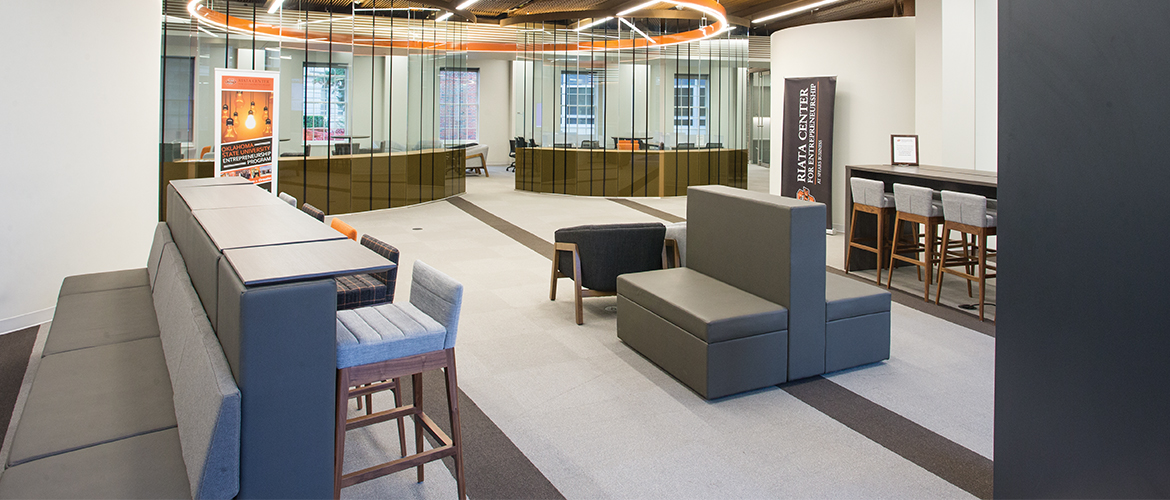
Turning 10
Thursday, August 29, 2019
OSU's School of Entrepreneurship celebrates its first decade
The School of Entrepreneurship at the Spears School of Business has had much to celebrate in its first decade, from the $28 million gift that made it all possible to unprecedented success in business plan competitions to an expanding list of successful business startups involving students from the program. But for Dr. Bruce Barringer, April 2019 was a watershed for the program’s student entrepreneurs.
“April has been the most successful month we’ve ever had in the program, with student teams winning a business plan competition at Princeton University and taking the top spots in the undergraduate and graduate divisions at the Love’s Entrepreneur’s Cup,” said Barringer, director of the school and the Student Ventures Chair and N. Malone Mitchell Jr. Chair of Entrepreneurship.
“This level of success shows the breadth of the student talent our program is attracting.”
The School of Entrepreneurship and its outreach office, the Riata Center for Entrepreneurship, is celebrating its 10th anniversary Nov. 15 with a gala that will welcome back OSU alumni Malone Mitchell III and his wife, Amy Mitchell, who made the program possible with their gift in 2009. Their passion for OSU and for starting businesses have inspired hundreds of students who have pursued ideas for businesses through OSU entrepreneurship training.
“As we looked back at the successes we had at that point, we thought it would be fantastic if that knowledge could be incorporated into entrepreneur classes and taught to students at a much younger age so they might go on to generate successful businesses and avoid some of the travails we had gone through,” Malone Mitchell said.
Along with celebrating the Mitchells’ legacy, OSU is marking the school’s growth to become one of the nation’s most successful entrepreneurship education, research and outreach programs and one of only a handful that can claim an entire school dedicated to entrepreneurship.
The school includes more than 300 undergraduates majoring and minoring in the discipline as well as hundreds of others taking entrepreneurship classes. A new generation of engineering and science students also hope to learn to launch technology product and services businesses.
“The College of Engineering, Architecture and Technology (CEAT) now offers a minor in entrepreneurship, so, for engineering to free up credit hours for entrepreneurship training is a real acknowledgement that this is valuable,” Barringer said.
In fact, several technology business startups created by OSU students have been partnerships between Spears and CEAT teams. Just one example is the student-led startup Contraire that is designing a wastewater treatment analytical control system developed by CEAT students and faculty. A Spears student and faculty members are assisting with a business plan that has placed in several competitions, including winning the Princeton University TigerLaunch contest.
The entrepreneurship program also includes a doctorate and graduate certificates that bring graduate students and faculty researchers together on work published in the discipline’s top journals. OSU entrepreneurship researchers tied for fourth among 500 international colleges and universities in a 2019 ranking of research productivity.
Barringer said the passion at OSU for developing entrepreneurial mindsets is helping fuel the state’s growing technology economy with the launch of numerous small companies. Student-led technology startups at OSU include Roll-2-Roll, a company that makes a guide system and computer algorithms for manufacturing rolled materials; Plasma Bionics, which invented a low-temperature medical instrument sterilization device; MITO Materials, which developed an additive to make a super-strong epoxy resin material; MaxQ, which makes safer containers for transporting blood products; and Infinite Composites, which makes containers for shipping and storing pressurized liquids and gases.
In the last five years, graduate students in the program have started 41 businesses while undergraduates have launched 52 startups that have raised a combined $13.5 million in capital.
Technology jobs bring the greatest potential for income growth in Oklahoma, according to Barringer, who cites a 2018 report by the Oklahoma Employment Security Commission that found the average annual wage for a STEM (science, technology, engineering and math) job in Oklahoma is $76,274 while the average wage for all occupations in the state is $43,340.
“Technology startups just create better-paying jobs,” Barringer said.
Even if a Spears entrepreneurship student doesn’t end up starting a business, the unique education creates opportunities with companies seeking creative employees.
“The way we teach entrepreneurship, it’s more than just starting businesses,” Barringer said. “All companies are interested in new markets, new products and new ways of thinking, and those are the value-adds that our graduates bring to a job.”
| Well Content |
|---|
| Learn more about entrepreneurship at okla.st/entre. |
